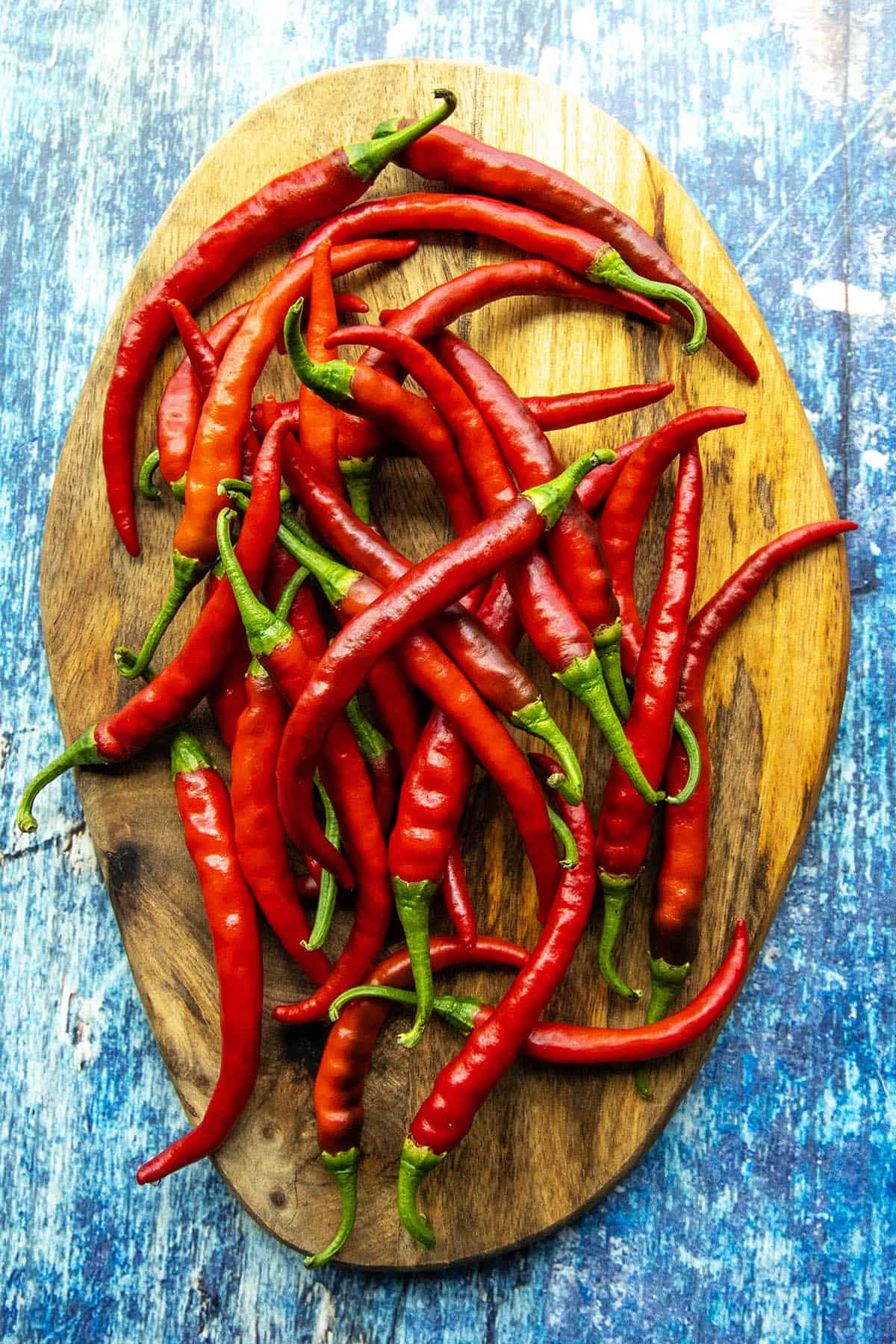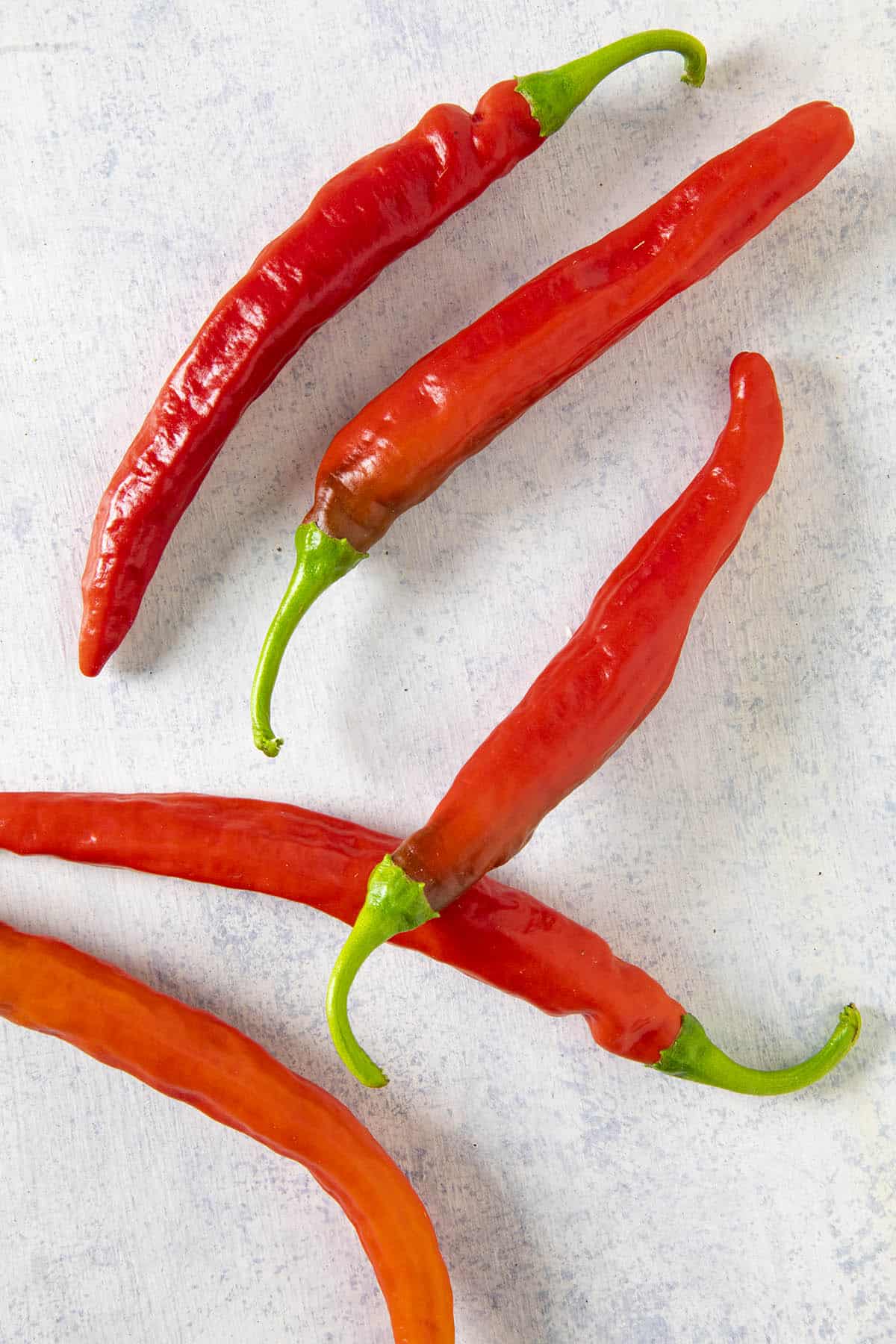The cayenne pepper is a thin chili pepper, green to red in color, about 2 to 5 inches long. The "cayenne pepper" spice you find mostly in pizza restaurants is the dried, ground version of this pepper. Learn more about them here.

Scoville Heat Units: 30,000 - 50,000 SHU
Capsicum Annuum
The cayenne pepper is a thin chili pepper, green to red in color, about 2 to 5 inches long. The "cayenne pepper" spice you use mostly in pizza restaurants is the dried, ground version of this pepper.
It belongs to the nightshade family of flowering plants and are related to bell peppers and jalapenos.
The cayenne is a bright red chili ranging from 2-5 inches long and about 1/2 inch in diameter. Cayenne chilies are usually sold as a powder, as cayenne pepper.
The word cayenne comes from the city of Cayenne in French Guiana. Cayenne is great in soups and sauces, on pizzas, as well as over meats and seafoods. Keep it on the table in a shaker as an alternative to salt or pepper.
History of the Cayenne Pepper
The cayenne is one of the most popular peppers used in the Western hemisphere. The name of the pepper is taken from the city of Cayenne in French Guiana, from where the pepper originates and where its first documented uses were found.
Cayenne peppers are usually used as a dried spice, which is made by drying and grinding the peppers or pulping and baking them into cakes, which are then ground to produce the spice.
Cayenne peppers can also be used fresh in dishes, but are a little harder to find outside of the powdered form.
About Cayenne Chili Peppers
Cayenne is a very popular pepper that is used in a variety of dishes and flavorings. You can buy cayenne pepper at most supermarkets in a variety of forms - the most noticeable form being the red powder, but the majority of chili flakes that can be found on the market are from Cayenne peppers.
In addition, the vast majority of popular hot sauces all rely on cayenne for part of their kick, particularly if the sauce also contains vinegar.
Growing Cayenne Peppers
The cayenne pepper is a sub-tropical to tropical plant natively, but they can be grown as annuals in temperate climates as well. They can even be overwintered if protected from frost.
Cayenne plants like some heat with a longer growing season and lots of sun, though they can react poorly to too much heat as much as too much cold.
Plant your seeds when temps are a minimum of 60 degrees F (16 degrees C) in well-drained soil. Seedlings should be spaced 18-24 inches apart in a row.
Be careful not to overwater. See my section on Growing Chili Peppers, as well as this page - a Guide to Growing Chili Peppers.
There are many different types of cayenne peppers, and I have grown many in my own garden. Here are some links to different types.
Types of Cayenne Peppers
When to Pick Cayenne Peppers
Harvest your cayenne peppers when the skins are somewhat waxy in appearance, and the flesh is firm. If they've started to soften, they most likely have started to rot and it is too late to pick them.
The color should be a vibrant red and the pods will be anywhere from 2 to 5 inches long. You can pick your cayenne peppers when they are green, though the flavor will be somewhat grassy and the heat not so intense.
The pods usually ripen in 70 days.

Are Cayenne Peppers Hot?
Cayenne peppers are considered a somewhat hot pepper, ranging from 30,000 – 50,000 Scoville Heat Units (SHU) on the Scoville Scale, which is about as hot as a serrano pepper. If you compare that to a typical jalapeno pepper, which averages around 5,00o SHU, the hottest cayenne is about 10 times hotter.
Cayenne Pepper Nutrition
5 grams (1 tablespoon) of cayenne pepper contains the following nutritional value:
- Calories: 17
- Fat: 1 gram
- Carbs: 3 grams
- Fiber: 1.4 grams
- Protein: 0.6 grams
- Vitamin A: 44% of the RDI
- Vitamin E: 8% of the RDI
- Vitamin C: 7% of the RDI
- Vitamin B6: 6% of the RDI
- Vitamin K: 5% of the RDI
- Manganese: 5% of the RDI
- Potassium: 3% of the RDI
- Riboflavin: 3% of the RDI
Health Benefits of Cayenne
Cayenne contains numerous medicinal properties and are good for your health. Studies have indicated that cayenne and other hot peppers can help boost your metabolism for weight loss, curb your appetite, lower blood pressure, aid digestion, relieve pan and reduce some Cancer risks.
Of course you should always seek medical advice from your physician if using cayennes or other peppers for health reasons, such as pain relief, but they are quite healthy for you.
The real benefits come from the active ingredient, Capsaicin.
Learn more about the benefits of cayenne.
Cayenne Pepper Substitute for Cooking and Recipes
A question I receive often is, what is a good substitute for cayenne pepper? If you happen to run out of cayenne powder, there are many different powders, blends and even hot sauces that you can use. See my post on cayenne pepper substitutes to help you.
Cayenne Pepper Recipes
There are many, many recipes you can make with cayennes for spicy food lovers. You can use them in any recipe that calls for a milder chili pepper to add a bit of extra heat and kick. I toss them into so many different recipes. Try some of these:
- Homemade Cayenne Pepper Sauce Recipe
- Homemade Cayenne Pepper Powder Recipe
- Get More Cayenne Pepper Recipes here
See also: What is Paprika?
NOTE: This page was updated on 10/7/2025 to include new photo and information. It was originally published on 9/27/2013.



Carol says
Hello Mike,
I bought cayenne seeds from an organic company online. When I started them I was careful to mark them with a colored stick as I was growing 5 different types of peppers. I planted 4 into my raised bed. Now that they are growing well and producing, they look nothing like cayenne that I have grown before. They are 3/4" around and about 8" long. Haven't started to turn red yet. My nephew has a special app which he took a pic and they were identified as cayenne peppers. What do you think? I could send a pic if you are able to receive them. Thanks,
Mike Hultquist says
Carol, you can email pics to me and I can try to help. It's mike@
Dianne Craftiemamma says
My pepper plant had a large seed pod growing out the top of it?! The pod was at least as big as the cayenne peppers themselves, but it stood straight up and the seeds are like little black peas. Thoughts anyone?!
A Knudson says
Does the powdered version of cayenne pepper get hotter over time? I used an 5 year expired powdered cayenne pepper and it seemed like it was hotter but maybe I'm just losing my heat tolerance?
Mike H. says
Not really, A. The heat level of cayenne pepper powder is determined by the amount of capsaicin it contains, and that level remains relatively stable. So that perception may come from either storage conditions or individual sensitivity. Over time, the flavor and aroma of ground spices can change, which might affect the perception of heat. Additionally, your own tolerance to spicy foods can vary, so what may have seemed milder in the past could be perceived as spicier if you've become less accustomed to heat.